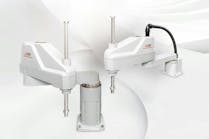Vertical Inline Pumps Save on Space, Installation for University of Miami
The Miller School of Medicine at the University of Miami is committed to becoming one of the country's leading bioscience research institutions. It also is striving to be a leader in sustainable building, with its new biomedical-research building, which it is hoping will achieve Silver certification under the U.S. Green Building Council's Leadership in Energy and Environmental Design (LEED) Green Building Rating System. The campus expansion required a new mechanical plant to cool the new research facility and future buildings.
The university's engineers wanted pumps large enough to provide 12,000 tons of chilled water, with the ability to meet future needs of 20,000 tons. To match this demand, Armstrong built its largest HVAC pumps. Armstrong supplied the university with three 20×20×19 vertical-inline (VIL) pumps with 600-hp motors and three 14×14×15 VIL pumps with 500-hp motors as part of the campus' new chiller system. The 20×20×19 pumps are condensing water units, while the smaller group of 14×14×15 pumps serves the chilled-water system.
The university's engineers looked at three different types of pumps for the project. They considered horizontal split-case pumps, VIL pumps, and vertical turbines. Atlanta engineering firm Newcomb & Boyd, Armstrong, and Armstrong's representative companies, Protec Inc. and John Q. Bullard, made a case to the university that VIL pumps would easily handle the demand and result in installation and space savings.
VIL pumps typically use one-third the space of horizontal split-case pumps, giving designers the ability to decrease the size of the mechanical room or combine multiple plant rooms into one.
“For every square foot of construction that we have, there is a cost to that,” Ronald Bogue, assistant vice president, facilities and services, for the university, said. “And we also wanted to build a plant with campus growth expansion in mind.”
Other factors that influenced the university's decision were maintenance and payback. Although the pumps are only part of the plant's overall payback period, the variable-speed VIL units contributed to cost savings. With the VIL units, the engineering firm was able to design the mechanical room so that it required less piping. Unlike base-mounted pumps, vertical pumps do not require an inertia base; instead, they are pipe-supported. Before ground was broken, the university knew it was saving tens of thousands of dollars on material and labor costs.
The most compelling reason why the university chose the Armstrong VIL pumps with vibration monitors is because the units are easy to maintain.
“The most enticing thing about the Armstrong pump was the ability to change out the mechanical seals without disassembly, as required with a lot of the other vertical pumps, where you actually have to pull the units apart,” Bogue said.
Getting the pumps inside the mechanical room presented a challenge, but was overcome with some planning. The contractor, Armstrong, and the university worked to create a schedule that allowed the contractor to keep construction going while giving Armstrong enough time to engineer, manufacture, and deliver the pumps before the mechanical-room walls were erected.
To keep occupants cool from the Miami heat, the pumps have been operating 24 hr a day, seven days a week since the end of March. The city experiences a tropical climate, with hot and humid summers and warm and dry winters. Spring temperatures reach an average high of 80°F, while summer temperatures average 90°F.
The university is satisfied with its decision and the savings that have come from the VIL pumps. The pumps and overall plant and piping layout have given the university a dramatic reduction in kilowatts per hour.
“The pumps so far have performed well with the VFDs (variable-frequency drives),” Bogue said. “They are efficient, absolutely responsive, and sensitive.”
Information and photograph courtesy of Armstrong.
Circle 100








